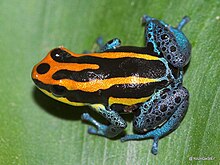Ranitomeya amazonica is a poison dart frog in the genus Ranitomeya.[3] It was first described by Rainer Schulte in 1999 as Dendrobates amazonicus when he separated it from Dendrobates ventrimaculatus, primarily on the basis of call characteristics. The validity of the species has been debated, but further studies, also including genetic data, support its validity.[4]
| Ranitomeya amazonica | |
|---|---|

| |
| Scientific classification | |
| Domain: | Eukaryota |
| Kingdom: | Animalia |
| Phylum: | Chordata |
| Class: | Amphibia |
| Order: | Anura |
| Family: | Dendrobatidae |
| Genus: | Ranitomeya |
| Species: | R. amazonica
|
| Binomial name | |
| Ranitomeya amazonica (Schulte, 1999)
| |
| Synonyms | |
|
Dendrobates amazonicus Schulte, 1999[2] | |
Distribution and habitat
editThis frog has been found in Peru, Colombia, French Guiana, Brazil, and Guyana. Scientists may infer that it also lives in Surname. It is diurnal and lives in primary forest and older secondary forest. Most of its habitats are pristine, but it has shown some tolerance to disturbance. It has been observed between 0 and 200 meters above sea level.[1]
Conservation status and threats
editIt is listed as "Least Concern" on the IUCN Red List based on the assessment from 2023. What threat it faces comes from habitat loss associated with agriculture and cattle cultivation.[1]
An assessment of fifteen frogs in French Guiana showed that about 13 percent were infected with the fungus Batrachochytrium dendrobatidis, which causes chytridiomycosis.[1]
This frog has been seen on the international pet trade, but because it is also raised in captivity, it is difficult to tell whether any given frog was raised in captivity or captured in the wild.[1]
The frog occurs in at least two protected parks, Reserva Nacional Alpahuayo Mishana and Reserva Comunal Tamshiyacu-Tahuayo, and scientists infer it could live in many more.[1][5]
Description
editRanitomeya amazonica is 16–19 mm long with smooth, black skin. The torso is laterally striped orange or red while the legs and arms feature a mesh of blue, grey or green on black. There is no explicit sexual dimorphism in this frog, but females tend to be slightly bigger than males.[6]
References
edit- ^ a b c d e f IUCN SSC Amphibian Specialist Group (2023). "Mimic Poison Frog: Ranitomeya amazonica". IUCN Red List of Threatened Species. 2023: e.T55172A85892431. doi:10.2305/IUCN.UK.2023-1.RLTS.T55172A85892431.en. Retrieved June 25, 2024.
- ^ Schulte, Rainer (1999). Artenteil Peru. Pfeilgiftfrösche (in German). Vol. 2. Stuttgart: Nikola Verlag.
- ^ Frost, Darrel R. (2015). "Ranitomeya amazonica (Schulte, 1999)". Amphibian Species of the World: an Online Reference. Version 6.0. American Museum of Natural History. Retrieved 28 April 2015.
- ^ Brown, J. L.; E. Twomey; A. Amézquita; M. B. de Souza; J. P. Caldwell; S. Lötters; R. von May; P. R. Melo-Sampaio; D. Mejía-Vargas; P. E. Pérez-Peña; M. Pepper; E. H. Poelman; M. Sanchez-Rodriguez & K. Summers (2011). "A taxonomic revision of the Neotropical frog genus Ranitomeya (Amphibia: Dendrobatidae)" (PDF). Zootaxa. 3083: 1–120. doi:10.11646/zootaxa.3083.1.1.
- ^ "New species discovered in the Amazon include a bald parrot and a tiger striped tarantula". Earth picture galleries. The Telegraph. Archived from the original on 2010-10-29.
- ^ "Ranitomeya amazonica (SCHULTE, 1999)". DendroBase (in German).
External links
edit- Data related to Ranitomeya amazonica at Wikispecies
- New species discovered in Amazon Yahoo News.
